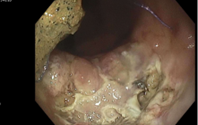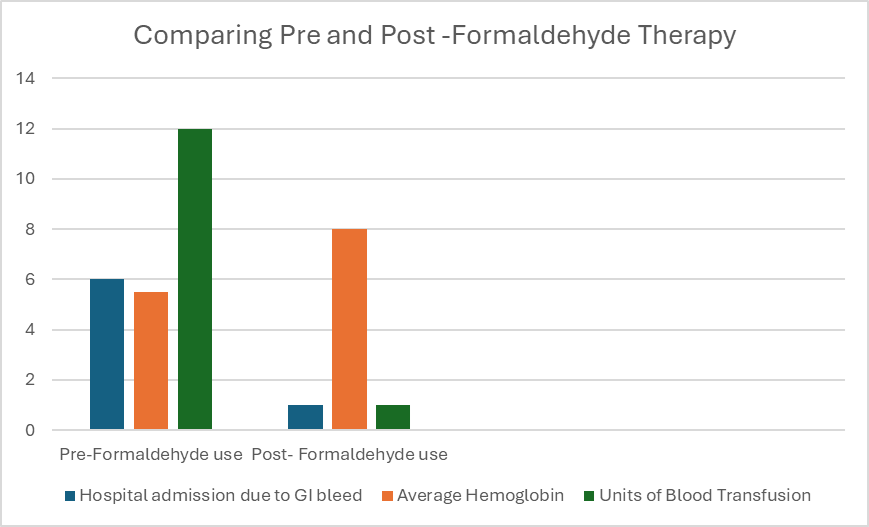Monday Poster Session
Category: GI Bleeding
P3099 - Formaldehyde Fix: A Novel Approach to Management of Radiation Proctitis Ulcers
Monday, October 27, 2025
10:30 AM - 4:00 PM PDT
Location: Exhibit Hall

Melvina chinagolum Nnam, DO (she/her/hers)
Charles Drew University Internal medicine Residency CA
Los Angeles, CA
Presenting Author(s)
Melvina chinagolum. Nnam, DO, Oluchi Nwankwo, DO, Mohammad Ahmed-Khan, MD
Charles Drew University Internal medicine Residency CA, Los Angeles, CA
Introduction: Radiation proctitis is a form of rectal mucosal injury as a consequence of radiotherapy to pelvic organs. A bleeding radiation proctitis ulcer presents significant challenges that often lead to medical complications ranging from severe blood loss anemia to death. The management of these ulcers is tailored on a case-by-case basis. Our case report highlights a novel use of formaldehyde as a modality for managing bleeding radiation proctitis ulcers.
Case Description/
Methods: A 71-year-old African American male with a relevant history of prostate cancer status post radiotherapy one year prior presented to the ED with increasing weakness and shortness of breath over the past few days. The patient’s vitals were stable, and on physical examination, rectal exam revealed bright red blood per rectum. A hemogram revealed a hemoglobin of 3.8, and urgent transfusions were initiated. The patient reported having multiple admissions for recurrent lower GI bleeds, and the chart review showed multiple sigmoidoscopy procedures with APC. He was also managed with hyperbaric oxygen as well as Carafate enemas, which unfortunately failed to control rectal bleeding. However, the endoscopic application of 4% Formaldehyde solution directly to the ulcer site was successful in achieving hemostasis. At one year follow-up post formaldehyde treatment, the patient had decreased lower GI bleed recurrence as well as hospital visits.
Discussion: The current management of bleeding radiation proctitis is challenging as well as personalized on a case-by-case basis. The interventions are based on ulcer grading, severity of symptoms, and limitations of the center and endoscopist. Our case presents the novel use and efficacy of formaldehyde therapy as an adjunct for managing bleeding radiation proctitis when conservative management, as well as APC, has failed. In the study by Yeoh et al, comparing APC and formaldehyde application, complete bleeding cessation was achieved in 100% of the patients in the formaldehyde group compared to 94% in the APC group. As clinicians, it is important to prioritize research and evidence-based practices to enhance patients’ outcomes with minimal adverse effects when faced with challenges of managing complex cases without a gold standard treatment.

Figure: Fig 1.1
Radiation Proctitis Ulcer

Figure: Pre- and Post-Formaldehyde use
Disclosures:
Melvina Nnam indicated no relevant financial relationships.
Oluchi Nwankwo indicated no relevant financial relationships.
Mohammad Ahmed-Khan indicated no relevant financial relationships.
Melvina chinagolum. Nnam, DO, Oluchi Nwankwo, DO, Mohammad Ahmed-Khan, MD. P3099 - Formaldehyde Fix: A Novel Approach to Management of Radiation Proctitis Ulcers, ACG 2025 Annual Scientific Meeting Abstracts. Phoenix, AZ: American College of Gastroenterology.
Charles Drew University Internal medicine Residency CA, Los Angeles, CA
Introduction: Radiation proctitis is a form of rectal mucosal injury as a consequence of radiotherapy to pelvic organs. A bleeding radiation proctitis ulcer presents significant challenges that often lead to medical complications ranging from severe blood loss anemia to death. The management of these ulcers is tailored on a case-by-case basis. Our case report highlights a novel use of formaldehyde as a modality for managing bleeding radiation proctitis ulcers.
Case Description/
Methods: A 71-year-old African American male with a relevant history of prostate cancer status post radiotherapy one year prior presented to the ED with increasing weakness and shortness of breath over the past few days. The patient’s vitals were stable, and on physical examination, rectal exam revealed bright red blood per rectum. A hemogram revealed a hemoglobin of 3.8, and urgent transfusions were initiated. The patient reported having multiple admissions for recurrent lower GI bleeds, and the chart review showed multiple sigmoidoscopy procedures with APC. He was also managed with hyperbaric oxygen as well as Carafate enemas, which unfortunately failed to control rectal bleeding. However, the endoscopic application of 4% Formaldehyde solution directly to the ulcer site was successful in achieving hemostasis. At one year follow-up post formaldehyde treatment, the patient had decreased lower GI bleed recurrence as well as hospital visits.
Discussion: The current management of bleeding radiation proctitis is challenging as well as personalized on a case-by-case basis. The interventions are based on ulcer grading, severity of symptoms, and limitations of the center and endoscopist. Our case presents the novel use and efficacy of formaldehyde therapy as an adjunct for managing bleeding radiation proctitis when conservative management, as well as APC, has failed. In the study by Yeoh et al, comparing APC and formaldehyde application, complete bleeding cessation was achieved in 100% of the patients in the formaldehyde group compared to 94% in the APC group. As clinicians, it is important to prioritize research and evidence-based practices to enhance patients’ outcomes with minimal adverse effects when faced with challenges of managing complex cases without a gold standard treatment.

Figure: Fig 1.1
Radiation Proctitis Ulcer

Figure: Pre- and Post-Formaldehyde use
Disclosures:
Melvina Nnam indicated no relevant financial relationships.
Oluchi Nwankwo indicated no relevant financial relationships.
Mohammad Ahmed-Khan indicated no relevant financial relationships.
Melvina chinagolum. Nnam, DO, Oluchi Nwankwo, DO, Mohammad Ahmed-Khan, MD. P3099 - Formaldehyde Fix: A Novel Approach to Management of Radiation Proctitis Ulcers, ACG 2025 Annual Scientific Meeting Abstracts. Phoenix, AZ: American College of Gastroenterology.
